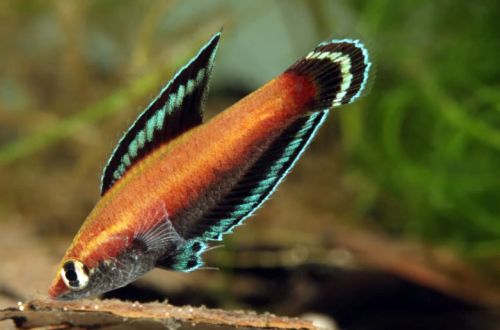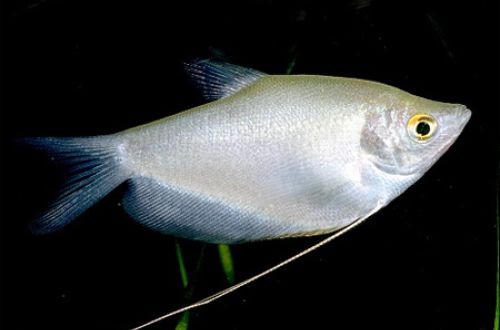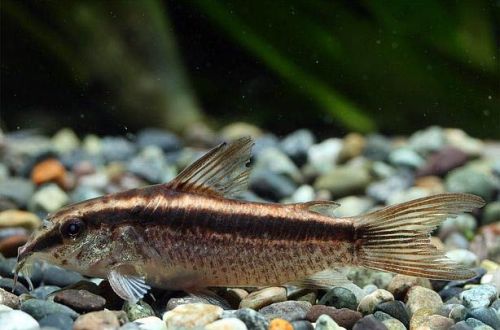
Parosfromenus dark
Parosfromenus dark or Kupanus dark, scientific name Parosphromenus nagyi, belongs to the Osphronemidae family. A small but temperamental fish, males in martial coloration will compete with many brightly colored species, which cannot be said about females. Successful keeping and breeding requires very specific water conditions, which can be difficult for beginner aquarists.

Contents
Habitat
Originates from a limited region of the east coast of Peninsular Malaysia (Southeast Asia). It lives in peat bogs and rivers flowing from them. The habitat is characterized by a large amount of aquatic vegetation, a low level of illumination due to the dense crowns of tropical forests and a high concentration of humic acids resulting from the decomposition of organic residues (leaves, branches, fruits, etc.), giving the water a brown color.
Brief information:
- The volume of the aquarium – from 40 liters.
- Temperature – 22-28°C
- Value pH — 3.0–6.5
- Water hardness – soft (1-4 dGH)
- Substrate type – any soft
- Lighting – subdued
- Brackish water – no
- Water movement – little or no
- The size of the fish is up to 4 cm.
- Food – mostly live or frozen food
- Temperament – conditionally peaceful, males are aggressive towards each other
- Keeping as a pair of male / female or in the form of a harem
Description
Adults reach a length of no more than 4 cm. The color is brownish with two horizontal stripes. In a state of spawning or aggression, males experience a significant color change – the body acquires a rich orange hue, the fins become black with bright blue stripes. The female remains the same.
Food
The basis of the diet should be live or frozen food (bloodworm, daphnia, brine shrimp). Dry and freeze-dried food is used only as a supplement, however, some breeders have been able to successfully adapt fish to receive these products. Before buying, be sure to check what Parosfromenus is fed at the pet store.
Maintenance and care, arrangement of the aquarium
Tank sizes for one pair of fish start at 40 liters. The design uses dense thickets of plants, a dark substrate and a large number of shelters in the form of snags, decorative objects (wrecks, castles), or various ceramic pots turned over on their side.
Water conditions should be maintained at acidic pH values with low carbonate hardness. To simulate natural conditions, a filtration system with peat-based filter material is used, and fallen leaves and alder cones are added to the bottom, which, during decomposition, color the water light brown and saturate it with humic acids. Before immersing the leaves with cones in the aquarium, they are first dried and then soaked until they begin to sink.
The equipment is also adjusted to the needs of the fish – low light levels and no internal current. An indispensable element should be a tight cover that prevents accidental jumping out and provides a warm, moist layer of air above the surface, which is important for the respiration of labyrinth fish species.
Maintenance comes down to regular cleaning of the soil from organic waste (excrement, uneaten food residues), weekly renewal of part of the water (10-15% of the volume) with fresh water and replacing leaves with cones every two weeks.
Behavior and Compatibility
The males of the dark Kupanus are belligerent towards each other and will defend their territory from competitors. In a large tank, with several shelters located at a distance, it is quite possible to keep two or more males, breeding them in their own areas. Females are more peaceful and do not come into conflict. They are calm with other species and can be successfully kept with fish of a similar size from among cyprinids or characins.
Breeding / breeding
Usually spawning takes place in small caves (ceramic crusts will come in handy) or among fallen leaves. With the beginning of the mating season, the male determines the place and begins to actively invite the female there, while driving away any competitor. He performs peculiar ritual dances, swimming around the female almost vertically with his head down, fluffing his fins as much as possible. When the female is ready, they swim into the shelter and produce up to 40 eggs, then the female leaves the clutch. The male remains to protect future offspring until the fry get out and hide and begin to swim on their own.
If there are other types of fish in the aquarium, the juveniles should be transplanted, since the protection of the parents can no longer be counted on.
Fish diseases
The main cause of most diseases is unsuitable living conditions and poor-quality food. If the first symptoms are detected, you should check the water parameters (pH and dGH) and the presence of high concentrations of hazardous substances (ammonia, nitrites, nitrates, etc.), if necessary, bring the indicators back to normal and only then proceed with treatment. Read more about symptoms and treatments in the Aquarium Fish Diseases section.





